Bhuj, Ahmedabad, Gandhinagar & Dholavira to Udaipur Sat 20 Feb – Sun 28 Feb 2010
Leaving outer Bhuj we planned to get well on the road to the rann area where the wild ass lives that night. To cut a long story short by the time darkness fell we seemed to be driving around in circles. The maps were inaccurate and some of the information we'd been given was frankly wrong. In despair we rang our guide friend Jamshed Turner and after speaking to locals and ascertaining where we were we found we'd gone in totally the wrong direction. The habitat of the wild ass is in the little rann south of where we were and we'd driven around 100km out of our way! Jamshed had recommended us a place to stay at a hotel/resort a friend of his ran. We were tired by now so we decided to camp at a nearby truck stop and start afresh from the next day! As mentioned before, as there is less developed tourism here and less English spoken Kutch is the one place we have come a bit unstuck on the directions front.
Next morning we got an early wake up call. Looking out we saw the parking area was now completely full of trucks that had moved in whilst we slept and there was a security man moving them out one by one with shrill blasts of his whistle - at 6am groan!!! !

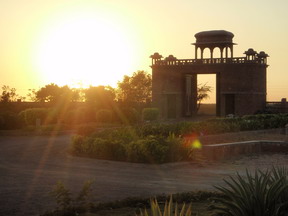
Anyway now we knew where we were, so fairly uneventfully we spent the day driving towards Banjana where the Royal Safari Camp was situated. We pulled up towards early afternoon and were a bit worried that they'd let us camp as it looked very grand - with imposing old gates - but we were quickly made very welcome by the Manager Mr. Mansur Muluk - who told us we were very welcome to camp and use their restaurant and that he'd accompany us as our guide on a safari early next morning. We spent a very relaxing afternoon just downloading our pictures and chilling out before enjoying a really nice dinner at the resort's restaurant.
The Royal Safari Camp was set up by Mr. Parvezkhan Pathan (who we met the next day) and has been going about 9 months. It was a great place conveniently situated just 90km from Ahmedabad, with lovely cottages and a really nice setting. Mansur and the team can arrange trips to see villages and/or local wildlife or you can use the resort to just relax. We loved our stay there and would really recommend it have a look at their site www.theroyalsafaricamp.com


Next morning we were up very early and we headed straight to the Little Rann sanctuary. This huge (4953 sq metres) stretch of vast salt cracked desert is home to the Ghudkhar or Asiatic Wild Ass - one of the most endangered rare species of animal in the world 4.500 now remain in this area the only place they are found in the world. It is also home to an impressive array of birdlife and is one of the few places in the world where flamingoes breed naturally. We stopped at a water hole and saw a lovely flock of pink flamingoes. Amazingly this whole area turns into lake in the monsoon season making it inaccessible whilst now in winter it is a barren harsh environment. In the monsoon season the asses retreat to "bets" or grass covered islands the only areas left exposed. They must be supremely hardy! The sanctuary is also home to black buck, wild boar, blue bull, foxes, wolves and jackals amongst others but we were just pleased to see some real wild asses! They are naturally elusive creatures so my pictures aren't that close up - but it was a real thrill to see them. Closer to horses than donkeys they are handsome creatures capable of running 50 km ph for long distances- a fact which probably helped them escape servitude!

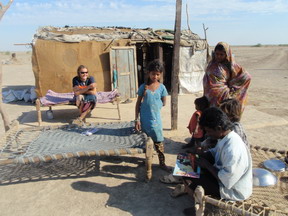
We then visited a nearby salt farm, which showed a really tough life being lived. Set throughout the rann these desolate farms comprising family groups eke out a living by pumping up ground water and extracting the salt. The work looked really punishing and labour intensive - particularly tough due to the harsh glare of the sun on the salt which sometimes results in blindness. The family we met were very kind and welcoming but their living conditions were pretty primitive. They work for the season out here - making approximately 25,000 rupees ($610 Aus) for 6 month's effort. Though there is a government school there is no bus provided so the children are unable to get there, meaning that sadly without an education this is probably all the life they'll know. There are various NGO initiatives in this area but they don't seem to have reached these people as yet. The salt they make they sell in its raw state for 10 rupees per 100kgs. Later it is sold on in the shops after refining packaging etc for around 12 rupees a kilo. They also sell the saline water to a nearby chemical plant for 100 rupees (around $2.43 Aus) for a 5.000 litre tanker full.

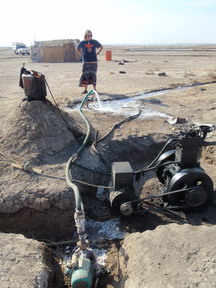
The white glare of the sun on the salt was pretty uncomfortable and we wished we'd bought some sunglasses for them. We gave the kids our tourist book of the region and they were amazed at the colour pictures in it.
On the way back we stopped off at the area of Kharagodha at a nearby magnesium factory run by a relation of Mansurs which is now operating a side line as a guest house /tour company "The Desert Outpost." Not as luxurious as Royal Safari this operates at a budget level hosting a lot of school groups and focusing particularly on bird watching safaris. The early 19th century house was built by a wealthy Parsi family who still own it to this day and it was a lovely property. We really liked the old dining room fan which still worked run by a motor and featuring wonderful Kutch embroidery work. To see the accommodation and services on offer have a look at their site www.thedesertoutpost.com
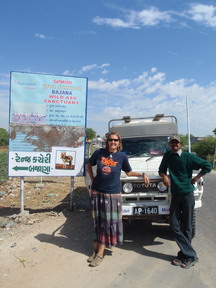

As we drove out we saw everywhere people of all ages hard at it loading the sacks of raw salt into piles from where they are stacked onto trains. This season of hard work is followed by a forcibly more relaxed time through the monsoon when the little rann fills with sea water. This introduction of sea water introduces prawns & small fish into the rann which means that for a while they are on the menu locally which must be an interesting change.
Our original plan had been to travel on to Dholavira in the north of Kutch next but as we'd ended up so close to Ahmedabad we decided to divert there for a couple of days and see the Calico Museum. We missed this on our first visit and various people had told us it was a real highlight so we decided to have a 2nd go at seeing it! So we spent a final evening at the Royal Safari Camp - where again we were really well looked after (and well fed) by Mansur, Parvezkhan and the team. Thanks again for such as good stay - we hope to be back one day!!
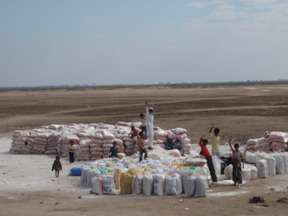
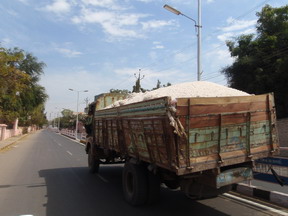
The next morning we were up at a ridiculously early hour to drive the 2 hours to Ahmedabad (A'bad" to ensure we got into the Calico Museum (CM) by 10.30am. This wasn't as mad as it sounded. Getting into the CM is a bit like getting into Eton. We'd had 2 abortive attempts on our last trip, once we fronted up on Wednesday to find that that was the one day a week for which the museum was closed. So we went the next day at 10.20am for the 10.30 kick off to find that all the tickets were gone. This time we'd rung the night before to book over the phone but were told that of the 30 tickets available only 15 could be booked in advance and as these were (naturally) all taken we had to take our chances by queuing on the pavement outside for the 15 remaining tickets.
So we drove to A'bad. On a trip like ours when we're always on the move it is nice to sometimes return to familiar ground and it felt a bit like coming home to be amongst familiar landmarks. A'bad still had the same crazy traffic with camels cows and even an elephant jostling for room alongside cars and auto rickshaws! We took one wrong turn but still ended up at the CM by 9.30am. A quick squizz showed us to be number 12 in the queue so we'd just made it. Whew!!!
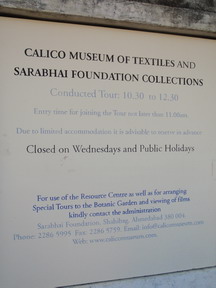
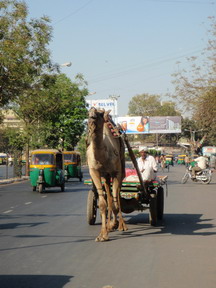
The CM is an amazing place run along the lines of a military dictatorship by a lady who is a member of the wealthy (Sarabhai) family whose home and collection this was. Many of the artifacts had been taken out of India and Mr. Sarabhai devoted a lot of time and effort to bringing them back. The family set up the collection and house as a non profitable charitable foundation in 1980 and it has been run as a museum ever since. Once in we all had to be 'processed" by security guards before "the system "was explained. The collection here comprises some of the world's best antique and modern Indian textiles, as well as a section on images/depictions of Indian gods which features some very old paintings on cloth from temples. The whole thing is beautifully & elegantly displayed both indoors and outdoors throughout a very lovely 1930 era house. Understandably there is a lot of effort put in to ensure the materials aren't damaged by light etc so the tour is conducted in a group so the lights don't remain on too long - hence the limited numbers.
Unsurprisingly given the number of rules here no cameras were allowed. It was a pretty whistle stop tour of 2 hours as there was certainly no time to linger. Most of us just accepted this but one older Israeli lady tried to ask for longer time to view some of the exhibits and was put firmly in her place "that is not the system."
I guess it is nice to see antiques so well cared for and for no admission charge the collection was very much worth seeing. I quite liked the "guard" and she helped make the experience for me. At the end the Israeli lady said "is it time now for me to ask my questions??" "No" said the guard "now it is time for you to leave!" What a woman !! Definitely see this if you can - it's best to get to the gate by 9 am to ensure a ticket. Bring a flask of chai!! Their site is www.calicomuseum.com which also shows the lovely 1930 Haveli which houses the collection.
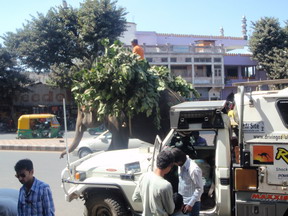
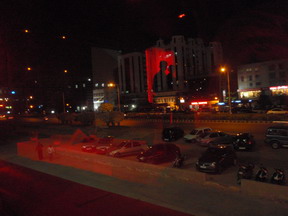
We spent the rest of the day ambling around A'bad and seeing a previously missed out Jain temple which we just stumbled upon. We checked back into the Toran Guest House opposite the Gandhi Ashram where we stayed previously and headed out for dinner. We were being treated by Parvezkhan from the Royal Safari Camp who is from A'bad and splits his time between here and the resort. We went to "Curries" a great restaurant a bit trendy by our usual standards with a great view out over the busy streets. Thanks Parvezkhan we really enjoyed it!

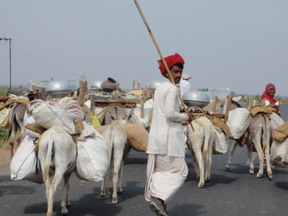
Back at the Toran Guesthouse we were pleased to get re-acquainted with another Indian friend Jerra. Jerra is the odd job man at the Toran GH and is a really cheery soul. His job is to sweep the yard area and we often wake up to him chucking away. Sadly his parents abandoned him when he was a child and he has been brought up by successive managers here, the Toran is the only home he has ever known. It was nice to see him again he was always such a happy soul!

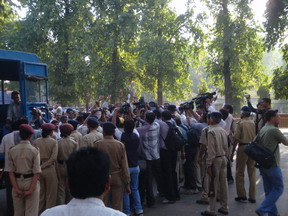
That morning back at the Toran there was a big commotion on the road outside. There was a protest going on by farmers. Protestors often choose the Gandhi Ashram as a rallying point due to its obvious associations with fights for justice. There was a big police presence as well as a lot of reporters and they kept moving the farmers on by police bus but more kept on coming. Thankfully it remained peaceful. The farmers have apparently had their land compulsively purchased at a low value by an industrialist and they are understandably angry. That's as far as we could understand anyway. In addition we'd seen a big police presence the night before driving around and a lot of roads blocked. Apparently this was the SA cricket team arriving to play tomorrow - it's all happening in A'bad!


That afternoon we stumbled across the National Museum. We'd not heard of it and it wasn't in any of our guide books but we went to have a look. It turned out to be a really interesting memorial to Sardar Patel. Sardar along with the better known Gandhi and Nehru was a major force in the fight for and re-structuring of independent India and the display was fascinating - we couldn't understand why it's not promoted more.
The 17th century palace was also interesting in its own right being originally built as a palace for Shah Jahan who later built the Taj Mahal, and the site where Tagore the famous late 19th century Indian poet composed some of his works.


We managed to fit in a meal at the House of MG - one of the top hotels in A'bad - the 1924 built home of wealthy industrialist Mangaldas Girdhardas - now a luxury hotel. We had had Xmas day dinner at their veggie "Green house" restaurant and we returned for a second helping of their hand churned ice cream! We also decided to go on their night walk - which we'd meant to do last visit and never managed to. The daily night walk doesn't kick off until 10pm , when its cool enough to walk and it was a bit past our bedtime but we were glad we made the effort. The tour started off at a beautifully restored (by the same Mangaldas Girdhardas) 200 year old Haveli now run as a café and craft shop. There were quite a few of us on the tour which took us around Abad's old city.
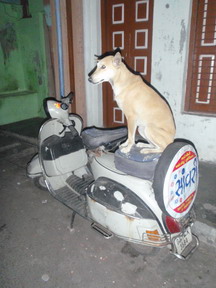
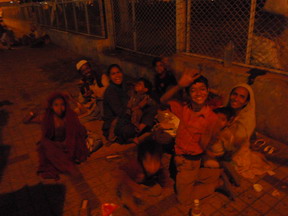
Dodging motorbikes, cows and dogs (and a few families of pavement dwellers) we negotiated the back streets looking at the old buildings and monuments including India's first stock exchange building. We might have missed out on some of the historical details - it was a big group - but it was a great look at the old city. By luck we were visiting at a time of celebration - not only was Abad's 600th birthday the next day, there was also a Muslim festival Id -E-Milad about to start and in the mainly Muslim old city a real party atmosphere prevailed. We'd noticed as we set off that the Sidi Saiyad Mosque was all lit up and looked beautiful. We actually took a picture of the exquisitely carved Jalis that afternoon when the sun came out. A really lovely building.
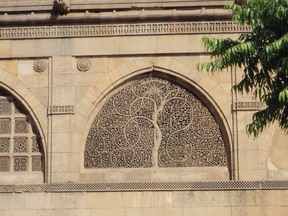
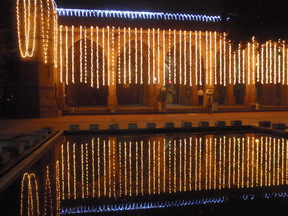
Towards the end of the tour we got to the busy food court of Manek Chowk which operates from 10pm until 2am every morning and was particularly busy today. We went through a small gateway and up some stairs to where some music was blasting out across the crowded courtyards. Incredibly 16 generations of this family have kept this tradition (started by a Muslim King ) alive and the drum and murli (a traditional flute) music plays to mark the closing of the city gates at 11pm each night.
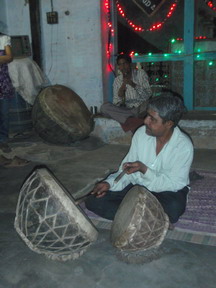
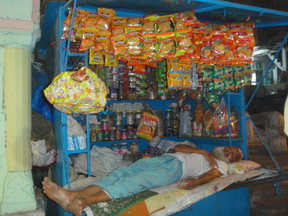
It never ceases to amaze me - a very light sleeper - how immune to noise people are here. The old man in our picture was taking a break from serving in his little store. There was so much noise around and he was sleeping like a baby right in the middle of it all ! The tour ended at the tomb of Sultan Ahmad Shah the man who founded A'bad in 1411, at the spot where he witnessed a rabbit /hare chasing one of his hunting dogs. This made him think the area must have special powers and thus was a good spot for a new city. This shrine built in 1442 also contains cenotaphs to his son & grandson.
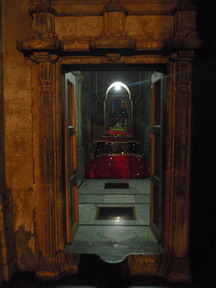

Women aren't allowed into the central chamber so Andrew took the camera in and I peered through the window. By the time we finished up it was close to midnight and the Muslim quarter was still rocking with families out and about having fun - presumably due to the festival starting. Have a look at House of MG's site which contains a section on the walking tours a bargain at 50 rupees. Their accommodation looks pretty good too - though not in our price range! www.houseofmg.com
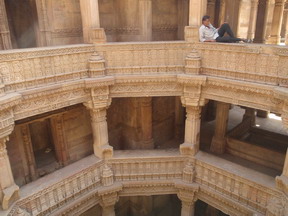
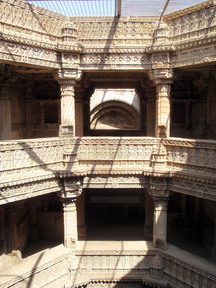
Next day we headed off on a trip to the official capital of Gujarat - Gandhinagar. On the way we stopped off at Adalaj Wav about 20km out of A'bad which is renowned for being one of the state's best baolis or step wells. Built by Queen Rudabai in 1499 it is a huge elaborate concern with 3 entrances and 5 storeys deep, decorated throughout with amazing carving. Legend has it that the Queen's (Hindu) husband was defeated by a Muslim King who wanted to take the Queen -a great beauty - as his wife. She agreed but asked that she first be allowed to complete the step well. She dragged the building of it out for 20 years which explains how elaborate it is.

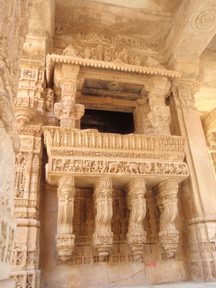
When the Muslim King finally demanded that they marry at once, after dedicating the well to her dead husband she threw herself into it and drowned. There were no signs in English and I was trying to ask one of the locals about the legend and where the Queen fell. He misunderstood and said "yes a school head master and teacher - after this they put up the net!!!" so there have obviously been later tragedies here too!! It was a bit scary in parts with huge open drops so we could well imagine the poor school teachers plunging to their deaths - they need a few safety railings particularly with all the school trips visiting.

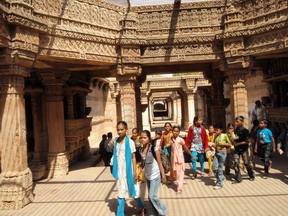
We drove on to Ghandhinagar which is India's 2nd planned city and reminded us of Chandigarh the first. There were lots of wide tree lined roads and big (heavily guarded) houses a lot of which are owned by politicians. The reason we were visiting was to see the Akshardham Temple. This spectacular building belongs to the very wealthy Swaminarayan sect aka BAPS - and we've seen a few of their temples on our travels. Apparently the current leader is in that big Indian favorite the Guinness book of records for building the most temples - 700 + in 30 years - including 2 in Oz and 7 in the UK.
In September 2002 about 10 years after the temple's completion 2 men (suspected Islamic terrorists but no one really knows) walked in and opened fire killing 31 people. For this reason the security was incredible - no phones, cameras and a full search which required men to remove their belts. It was an amazing building built out of 6000 tonnes of pink sandstone and the lawns around were immaculate. It had a full on display on the life of their leader and somewhat incongruously a fun fair with rides on the way out!!
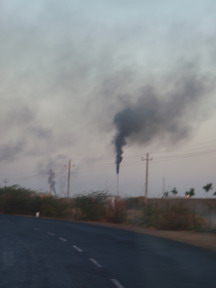
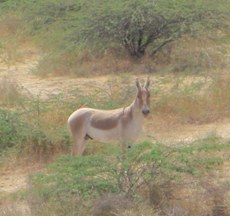
After a final night in A'bad on Saturday 27 February we drove north again on the road towards Kutch. There was a great deal of pollution - Gujarat currently makes a lot more money from industry than tourism! We left the pollution behind as we hit the little rann again - and were excited to see a wild ass just off the highway - we thought we'd seen our last ones at the sanctuary! The police permit we needed to visit much of the Kutch area was due to expire the next day and someone had told us it was possible to get this extended at the police station at Raper a little town on the road to Dholavira. We stopped here and tried to find the police station which involved driving down some scarily narrow streets. Eventually we found it and were shown into the top man's room and made very welcome. He told us he was working on a murder and hadn't been home in 3 days. All the time we were there a couple of men in tribal dress sat quietly on the floor next to his chair - police? …suspects? Anyway we had a chat and our tea and he photocopied all our documents but then told us an hour or so later that no one there had the authority to extend the permit so we were no further forward!
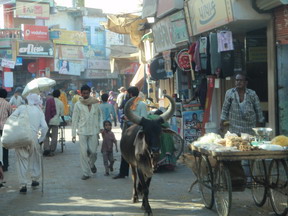
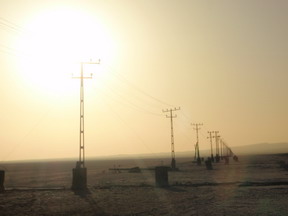
We drove on towards our next destination of Dholavira a remote village at the far NW of Khadir an island in Kutch. The road was actually very good - brand new - which we weren't expecting, perhaps it's been upgraded due to the heavy army presence here because of the proximity to Pakistan.
We drove down the path in the middle of the white rann as the sun set, which was really eerie in the fading light the salt looking very much like snow. We camped at the nearby Toran Guest house - the only hotel in town. They were a bit funny about letting us park at first - worried about whether we could still fill in the infamous C forms for foreigners required by the police if we didn't have a room - but thankfully they eventually let us. There was a full moon and we wanted to take some pictures of the white rann so we went and asked the army. They were very accommodating and sent one of their guys to guide us.
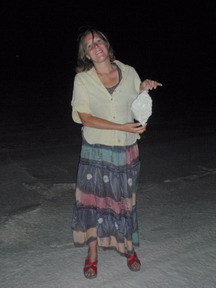
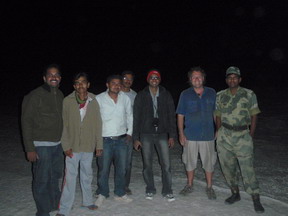
We'd also met up by this point with a few guys on bikes from A 'bad so off we all went. It was quite a spectacular sight - the salt crust is deceptive quite slippery in parts and you can easily step on an air pocket so you wouldn't want to drive on it. The salt isn't harvested as the whole area is a national park so the huge salt crusted expanse you see is entirely natural. In the monsoon it fills up with water so it is inaccessible though the roads to Dholavira remain open. We didn't really need the army guide - maybe he was there to keep an eye on us - and he was very keen to get back to the cricket (India playing SA in A'bad) on TV so we didn't linger long!
The next day we headed to the reason we were here - the nearby Harappan historical site of Dholavira. Also known as the Indus Valley Civilization the Harappan Civilization dates back to 2500 BC making it one of the world's first civilizations. We had a look around the museum and then a guided tour around the site.
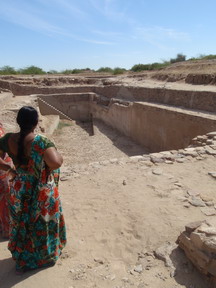

These people were incredibly ahead of their time having a sophisticated water collection system by which river water was saved in 16 tanks and pumped throughout the city. There were lots of artifacts on display from terracotta bangles and pots to games (hop scotch) and jewelry and ornate seals and even 10 ancient signs in Harappan script - the oldest sign boards in the world - though these have been removed to a Delhi museum.

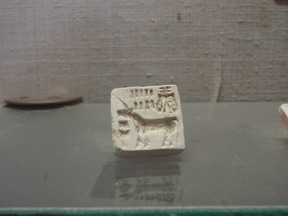
Eventually their culture declined here (no one is quite sure why) and the people all migrated throughout Gujarat. Measuring 600m x 775m - 100 hectares in all - Dholavira was a well planned large and complex town settlement. It was strange to imagine a huge kingdom once existing in this remote "end of the world" region and it was worth a visit.
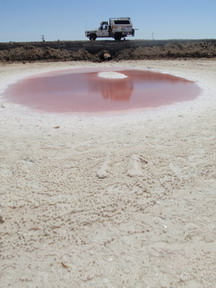

On Sunday 28 February we drove away from Kutch for the last time on the final day of our permit. The white rann looked lovely under the sun - the minerals had turned large patches of the salt pink an attractive effect and there was bird life everywhere. This area was one of only a few in India where we ever felt entirely alone - we went for phases of 30 minutes or so without seeing any cars/vehicles which is amazing in heavily populated India!
That morning we drove on across National Highway 8. On the way we stopped at a toll gate where we were swamped with people taking our picture . We get this a lot - we think some of the interest is due to the fact people think we are from "Animal Planet" - the Discovery Channel show which is big here as apparently our vehicle is similar!
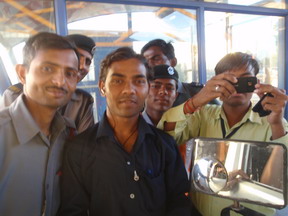
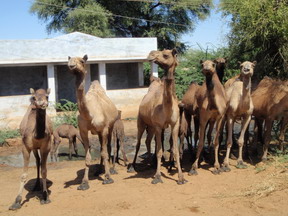
As the sun set we said a final goodbye to Gujarat and crossed back into Rajasthan where (retracing our steps just a bit) we head next to the "world's most romantic city" of Udaipur.
